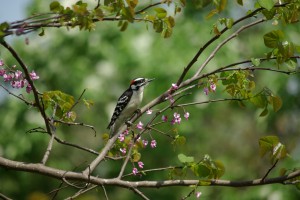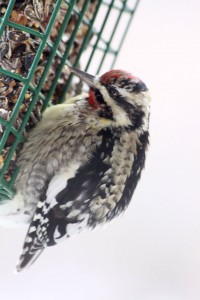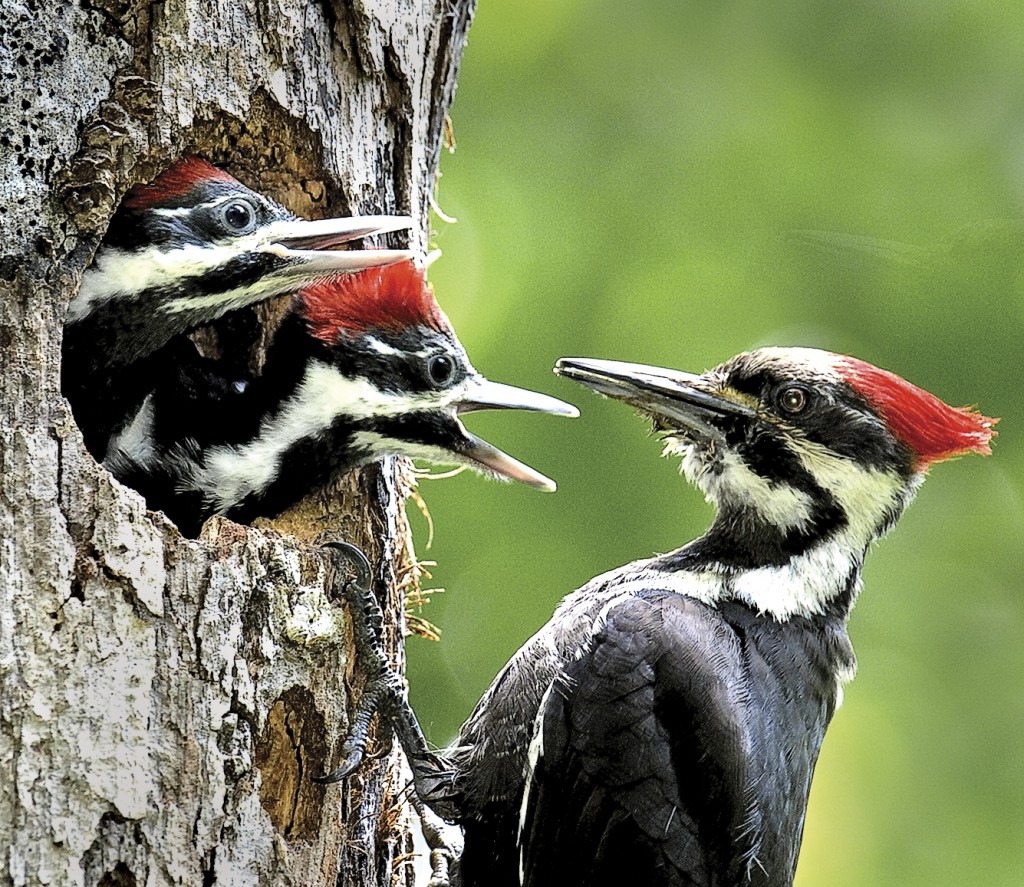Woodpeckers are wonderful & audible part of our natural habitat
If you are lucky enough to live near woodlands and you feed birds, you know very well that June is the month for woodpeckers in our area. Watching woodpecker parents trying to teach their still-clumsy but highly energetic eager youngsters the proper flight and landing patterns needed to manage a suet feeder can provide hours of chuckles akin to seeing a toddler’s first steps.
There are seven species of woodpeckers in our area; six species are here year round and one is only here in winter.
All of our woodpeckers share some anatomical features directly related to their feeding habits and lifestyles. All have “zygodactyl” feet, meaning two clawed toes on the front portion of their feet and two clawed toes facing backward. Coupled with stiff, strong tails, used almost as a third leg to brace themselves, woodpeckers are adept and skilled at clinging to and scurrying up and down trees.
All of our woodpeckers also have strong, chisel-like bills, extremely strong neck muscles in comparison to other birds, and unique, bone-reinforced skull plates, adaptations which collectively allow them to hammer and pound their way through life. Although members of different families, woodpeckers and hummingbirds share a unique tongue design, with a long, coiled-up extension stored deep along the back of their skulls, a design ideally suited to a similar feeding method: the ability to probe deeply for food sources. Unlike hummingbirds, woodpeckers’ tongues have horny and barbed tip modifications, which work to grab and hold the insect food bug bites they need to survive.
None of our woodpeckers sing–they drum. They stake out and defend territory and try to attract mates by drumming away on trees, or if you’re unlucky, your garage, gutters or other handy household expanse that can reverberate and amplify sound. Males of all of the woodpecker species in our area have varying degrees of red featheration somewhere on their heads; females of some species also sport red colors. Native Americans referred to woodpeckers collectively as “Firebirds” and believed them sacred providers of an early warning of lightening.
Pileated Woodpeckers are our largest species, almost crow-sized, up to 16 inches long. Both sexes sport bright red crests, have a white neck line, all black body, and white under wings, edged with black. Male Pileateds have a red mustache. Pileated Woodpeckers only inhabit our deepest forest–and to find them is a sure measure of an expansive healthy forest. They almost exclusively eat black carpenter ants and drill a series of oblong cavities in diseased or dead trees to get to the ants. In late fall and winter they supplement their diets with fruits and berries.
Red-headed Woodpeckers prefer more open stands of woods and forest edges. The 9 inch long bird has a beautiful deep red head and neck, jet black back and white belly and bold white wing patches. Redheads will only nest in cavities in dead tree snags. They eat insects, acorns and nuts, and fruits and berries.
Red-bellied Woodpeckers are about the same size as a Redhead. More versatile than a Redhead, Red-bellies can live deep in the woods or in more open habitats. Males have red crowns and red on the nape of their necks; females only have a red nape. Both sexes have zebra-striped black and white backs. As even the most casual observer would note, this species more properly should carry the common name “pink-blush belly,” for that is the extent of color on their abdomen. Red-bellied Woodpeckers will only nest in cavities drilled into living trees. They too eat insects, fruits and berries.

Downy or hairy woodpecker? Both these "look-alike" species are year-round residents. Pen DauBach, Clifftop.
Downy Woodpeckers are the smallest year round resident woodpecker in the area, with a length of about 6 inches. A slightly larger cousin, at 9 inches long, Hairy Woodpeckers are also permanent residents. Both Downies and Hairies have black and white heads, white backs, and white-spotted black wings. The males of both species also sport small red patches on the back of their heads.
Even though they look so similar that a Downy often is described as a miniature version of a Hairy Woodpecker, the two species can be told apart. Downies have shorter bills, about half the length of the width of their heads. Downy Woodpeckers also frequent forest / woodlot edges, and they forage for insects on the surface of tree trunks by climbing in jerky, fidgety movements.
Hairy Woodpeckers, on the other hand, prefer bigger and deeper woods, have long bills, as long as the width of their heads, probe deep into tree bark for insects, and move up and down tree trunks in short leaps.
Northern Flickers are another yearlong resident woodpecker in the area. The foot-long, Jay-sized bird has a brown back, speckled breast, narrow black bib at the neck, black tail, prominent white rump, and a small red patch on the nape of the neck. Male flickers have a black mustache. Flickers spend a lot of time foraging on the ground for their favorite food item, ants. They exhibit an unexplained feeding behavior called “anting.” They will pick up an ant or two and rub them on their plumage before eating. Flickers inhabit a variety of habitats with trees, but do not hang out in dense forests.

Yellow-bellied sapsuckers migrate through our area, sometimes spending the entire winter, and often visit feeder areas. Paul Feldker, Clifftop.
Our only migratory woodpecker is the Yellow-bellied Sapsucker. They only spend the winter in our area. Sapsuckers are about 8 inches long, have a red forehead patch (the males also have a red throat), dull yellow bellies, white wing patches, and an extensive white and black barring on the back. They inhabit forest openings, especially near water. Despite the name, Sapsuckers don’t suck sap, they lap it. They drill small pits, in parallel rows, in living trees and lap sap as a principal food source.
Statewide population trends for the species that live here year round show that there are clearly four winners and two losers. Downy, Hairy, Red-bellied and Pileated Woodpeckers have increased their numbers and expanded their ranges northward because of the increase in mature forest acreage in northern and central Illinois over the last 100 years. These four species are stable and prospering in our area.
On the other hand, because of the decline in open-canopy, savannah-like woodland habitat throughout the state over the last century, Red-headed Woodpeckers and Northern Flickers are in serious decline over much of Illinois. Their numbers appear stable in Southwestern Illinois due to the remaining wealth and diversity of natural area habitats.
Woodpecker populations can benefit from a few human assists. Leaving standing dead trees that pose no danger to humans and human infrastructure provides potential feeding, nesting and drumming sites. Allowing for messy edges around fields and pastures and the preservation of field edge tree and shrub borders creates valuable habitat for woodpeckers and numerous other species. Many woodpecker species, including Hairy, Downy, Red-bellied, and Red-headed, will readily come to backyard feeding stations for both water and food and will chow down on sunflower seed and suet cakes, and, even the nectar in hummingbird feeders. Downy woodpeckers especially seem to enjoy the sweet energy-packed sugar water and may monopolize the feeder. Woodpeckers may be lured away from hummingbird feeders by additional suet cake stations. Hummingbird feeders that do not have perches allow hummingbirds to hover- feed but deter woodpeckers as they need a place to land before drinking.
CLIFFTOP, a local nonprofit organization, is focused on preserving and protecting area bluff lands.
A version of this article appeared in the June 15, 2012 edition of the Monroe County Independent.
© 2012 all content rights reserved Clifftop NFP
Comments are currently closed.

